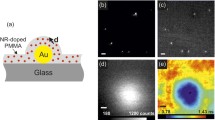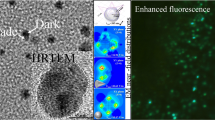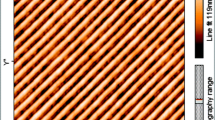Abstract
In recent years both the mechanism and applications of metal-enhanced fluorescence (MEF) have attracted significant attention, yet many fundamental aspects of MEF remain unanswered or addressed. In this study, we address a fundamental aspect of MEF. Using fluorescein-labeled different length DNA scaffolds, covalently bound to silver nanodeposits, we have experimentally measured the distance dependence of the MEF effect. The enhanced fluorescence signatures, i.e., MEF, follow quite closely the theoretical decay of the near-field of the nanoparticles, calculated using finite difference time domain approaches. This implies that the mechanisms of MEF are partially underpinned by the magnitude and distribution of the electric field around near-field nanoparticles.







Similar content being viewed by others
References
Aslan K, Geddes CD (2010) In: Geddes CD (ed) Metal-enhanced fluorescence: progress towards a unified plasmon-fluorophore description. Wiley, Hoboken, NJ, pp 1–24
Geddes CD, Lakowicz JR (2002) Metal-enhanced fluorescence. J Fluoresc 12(2):121–129
Geddes CD (2010) Metal-enhanced fluorescence. Wiley, Hoboken, NJ
Lakowicz JR (2006) Principles of fluorescence spectroscopy. Springer, New York
Zhang Y, Dragan A, Geddes CD (2009) Wavelength dependence of metal-enhanced fluorescence. J Phys Chem C 113(28):12095–12100
Kummerlen J et al (1993) Enhanced dye fluorescence over silver island films: analysis of the distance dependence. Mol Phys 80(5):1031–1046
Ray K, Badugu R, Lakowicz JR (2007) Polyelectrolyte layer-by-layer assembly to control the distance between fluorophores and plasmonic nanostructures. Chem Mater 19(24):5902–5909
Ray K, Badugu R, Lakowicz JR (2007) Sulforhodamine adsorbed Langmuir–Blodgett layers on silver island films: effect of probe distance on the metal-enhanced fluorescence. J Phys Chem C Nanomater Interface 111(19):7091–7097
Sokolov K, Chumanov G, Cotton TM (1998) Enhancement of molecular fluorescence near the surface of colloidal metal films. Anal Chem 70(18):3898–3905
Anger P, Bharadwaj P, Novotny L (2006) Enhancement and quenching of single-molecule fluorescence. Phys Rev Lett 96(11):113002
Kuhn S, Hakanson U, Rogobete L, Sandoghdar V (2006) Enhancement of single-molecule fluorescence using a gold nanoparticle as an optical nanoantenna. Phys Rev Lett 97(1):017402
Aslan K et al (2005) Metal-enhanced fluorescence: an emerging tool in biotechnology. Curr Opin Biotechnol 16(1):55–62
D’Agostino S et al (2009) Enhanced fluorescence by metal nanospheres on metal substrates. Opt Lett 34(15):2381–2383
Dragan AI et al (2010) Metal-enhanced picogreen fluorescence: application for double-stranded DNA quantification. Anal Biochem 396(1):8–12
Mackowski S et al (2008) Metal-enhanced fluorescence of chlorophylls in single light-harvesting complexes. Nano Lett 8(2):558–564
Matveeva EG et al (2007) Metal particle-enhanced fluorescent immunoassays on metal mirrors. Anal Biochem 363(2):239–245
Pribik R et al (2009) Metal-enhanced fluorescence (MEF): physical characterization of silver-island films and exploring sample geometries. Chem Phys Lett 478(1–3):70–74
Dragan AI et al (2011) Two-color, 30 second microwave-accelerated metal-enhanced fluorescence DNA assays: a new Rapid Catch and Signal (RCS) technology. J Immunol Methods 366(1–2):1–7
Pernice WHP (2010) Finite-difference time-domain methods and material models for the simulation of metallic and plasmonic structures. J Comput Theor Nanosci 7(1):1–14
Stoermer RL, Keating CD (2006) Distance-dependent emission from dye-labeled oligonucleotides on striped Au/Ag nanowires: effect of secondary structure and hybridization efficiency. J Am Chem Soc 128(40):13243–13254
Acknowledgments
The authors thank MedImmune Inc., for financial support as well as the University of Maryland Baltimore County for salary contributions.
Author information
Authors and Affiliations
Corresponding author
Rights and permissions
About this article
Cite this article
Dragan, A.I., Bishop, E.S., Casas-Finet, J.R. et al. Distance Dependence of Metal-Enhanced Fluorescence. Plasmonics 7, 739–744 (2012). https://doi.org/10.1007/s11468-012-9366-0
Received:
Accepted:
Published:
Issue Date:
DOI: https://doi.org/10.1007/s11468-012-9366-0




